![]() 1st Battalion 22nd Infantry
1st Battalion 22nd Infantry ![]()
Kit Carson Scouts and Saigon
by Michael Belis
During the Vietnam War, the
Chiêu H![]() i program was set up by the South
Vietnamese government to utilize enemy soldiers
i program was set up by the South
Vietnamese government to utilize enemy soldiers
who had surrendered and “rallied” to the South
Vietnamese cause. The words “Chiêu H![]() i” (pronounced “chew hoy”) were
i” (pronounced “chew hoy”) were
figuratively translated into the phrase “Open Arms”. An
NVA (North Vietnamese Army) soldier or VC (Viet Cong) soldier
who voluntarily surrendered and joined the South Vietnamese
government forces was called “H![]() i Chánh” (H
i Chánh” (H![]() i Chánh Viên)
i Chánh Viên)
loosely translated to mean "members who have returned to the
righteous side".
Millions of propaganda leaflets
were dropped by air over contested areas of the country, urging
communist soldiers
to desert Hanoi’s cause and join with their countrymen in
South Vietnam. The leaflets were used as “safe conduct
passes”
by surrendering NVA and VC.
Above: Insignia for the |
|
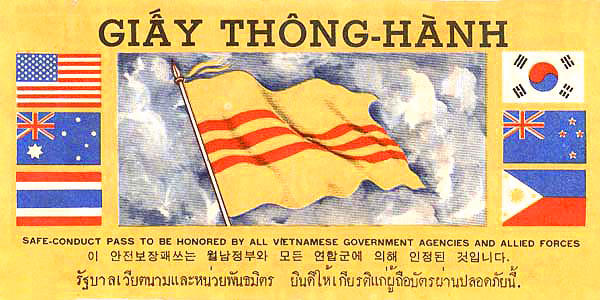
Above: Propaganda
leaflet Safe Conduct Pass (front) showing the flags of the seven
Allies.
The phrase at the top figuratively translates to the term
"Safe Conduct Pass."
I found one of these on the ground while we were on search and
destroy in
Bình Ðinh Province in September-October
1970 and brought it home from Vietnam.
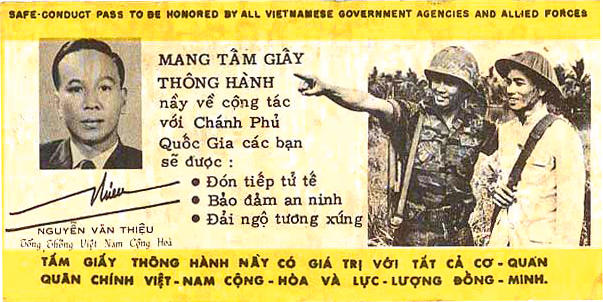
Above: Reverse side of above leaflet showing
the President of South Vietnam and a smiling
South Vietnamese soldier and a smiling communist soldier, now
happy to be buddies.
The text in the center of the back of the above leaflet is
loosely translated to read:
CARRY THIS SAFE
|
Following the lead of the US
Marine Corps, the US Army used some of these former communist
soldiers who had rallied
to the South Vietnamese government side as scouts to serve with
Army units. They were called “Kit Carson Scouts”,
or “KC’s” for short, and many worked with American
units in the same area they had previously operated in
as part of the communist forces.
In the fall of 1970 3rd Platoon
of Company C 1/22 Infantry had two former North Vietnamese Army
soldiers serving as
“Kit Carson Scouts”. They both had the same name which
was pronounced "tin". I dont know the correct spelling
of
that name. It possibly could be Tinh or Thinh but I remember Mike
Hernandez telling me at the time that it was spelled Tien.
So I'll use Tien in this narrative until someone can supply me
with the correct name.
One of these guys was big for a
Vietnamese, as tall as most Americans, and the other
was short and small in stature. We called the big one Big Tien
and the smaller one Little Tien.
Big Tien was extroverted and
brash. He liked to laugh, but also had a quick temper that was
easily set off. He spoke quite a bit of
English reasonably well. Little Tien was sullen, quiet and
unfriendly. He spoke a little English. Though they were called
“Scouts”,
they weren’t really used by us as scouts. During our mission
in the mountains between An Khê and Binh Khê, which lasted
all of September and into October, G.I.’s walked point,
broke brush and conducted all of the small patrols.
Our “Scouts” always
walked in the middle of the column, and were reluctant when
summoned forward, whenever our
point element discovered evidence of the enemy. None of us fully
trusted these guys, and a lot of the G.I.’s really
didn’t like them either. There was constant friction between
them and us, and frequently someone had to step in
to keep the “Scouts” and G.I.’s from starting
their own war with each other.
The “Scouts” slept in
hammocks at night, while we were forbidden to do so. They
didn’t have to pull duty in OP’s
(Observation Posts) or LP’s (Listening Posts) nor go on the
small patrols we conducted away from the main body.
In fact, they were exempted from most of the nasty or dangerous
duty that all of the rest of us had to endure.
One event forever ended any
possible trust between the two KC's and most of the G.I.'s in our
Platoon. Back in September,
when we were out in the boonies, one of our encounters with the
enemy happened as we were descending the side of a
jungle covered mountain. Our Platoon had come upon an enemy hut
or "hooch" by a stream. Little Tien was sent forward
to help give an assessment of the find. As we explored the site
we observed the two enemy soldiers, who were obviously
the occupants of the hooch, in a clearing across the stream,
coming our way, returning to their hooch. We moved into
an ambush position to intercept them, but before we could, Little
Tien opened fire on them with his rifle, missing both
of them and causing them to flee into the jungle and make their
escape.
Big Tien and Little Tien had
been assigned to our Company since we were operating in the same
area
they had operated in before, when they were on the enemy side. It
was believed that Little Tien had opened fire
early, before the enemy soldiers were in our kill zone and before
we had set up our machine gun, in order to
warn them away and prevent us from capturing or killing them. It
was even possible he recognized
them as friends and fired over their heads so they could get
away.
Resentment and conflict between
the two scouts and most of the G.I.'s in our Platoon escalated
for a couple of months
after that, with a lot of arguing and a couple of fights, until
the Company Command decided to return them to the
Chiêu H![]() i program, with an explanation that they
were not wanted or needed by us.
i program, with an explanation that they
were not wanted or needed by us.
I personally got along well with
both KC's, though I never could manage to get Little Tien to even
crack a smile.
But after the event out in the jungle and the
growing animosity between them and the Platoon, even I had to
admit
they were detrimental to our ability to work together as a unit.
Jim Regalia and I had both
served with Company C (in different platoons) out in the jungle
in the fall of 1970, and when we
were pulled out of the field after our last search and destroy
mission we both had been recommended for promotion to Sergeant.
We had separately appeared before the promotion board, had been
approved by the board and were awaiting orders confirming
our promotions. In late December 1970 we were summoned to the
Company Commander’s office where we were informed
we would be escorting my Platoon's two Kit Carson Scouts to the
National Chiêu H![]() i Center in Saigon. Jim later intimated to me
i Center in Saigon. Jim later intimated to me
that he believed this was a final test to prove we were worthy of
promotion.
On Christmas Eve morning
December 24, 1970 Jim and I left Tuy Hòa by aircraft with Big
Tien and Little Tien.
Jim and I were each issued a sidearm in case the KC's did not
want to co-operate and be returned.
They were, in effect, to be considered prisoners under our care.
The C-7 Caribou transport
aircraft we flew in landed at Tan Son Nhut airport in Saigon in
the morning of December 24.
We met with the U.S. Military Police at the airport who were to
bring us all to the Chiêu H![]() i Center in the city.
i Center in the city.
I was not happy with the transportation that had been arranged.
The M.P.'s had either a ¾ or 1 ¼ ton truck
(I don't remember which) that had its rear cargo area enclosed
with a wire cage to hold prisoners. Jim and I
were told to get in the cage along with our prisoners. Seemed to
me they could have provided one more vehicle
so Jim and I didn't have to ride in the locked cage like we were
prisoners ourselves. Guess I wasn't as special
as I thought I was. Since it was my first and only visit to
Saigon the entire city was unfamiliar to me
and I couldn't say where exactly in the city the Center was.
We arrived at our destination,
the Chiêu H![]() i Center, which was an Oriental pagoda
style building of several stories high.
i Center, which was an Oriental pagoda
style building of several stories high.
During the trip Big Tien and Little Tien had behaved just fine
and shown no emotion, but as we got to the Center their
demeanor changed abrubtly. They became sad, nervous, and it was
obvious they were a bit fearful as well.
Jim and I escorted our two KC's
inside the building and were directed to the second or third
floor. We reported to
a Vietnamese officer who sat behind a large desk in a large room
with large windows open to the outside air.
He was less than cordial and almost hostile in his attitude
toward us, and I was very happy when he finally signed
our orders relieving us of the responsibility of our charges. We
wished Big Tien and Little Tien good luck and
got out of there as quickly as we could. The poor guys looked
like two little kids who knew
they were about to get a good spanking.
They most likely received a lot
more than that. Their being returned by the American unit they
were sent to work with
must have caused considerable embarrassment to the Chiêu H![]() i program.
i program.
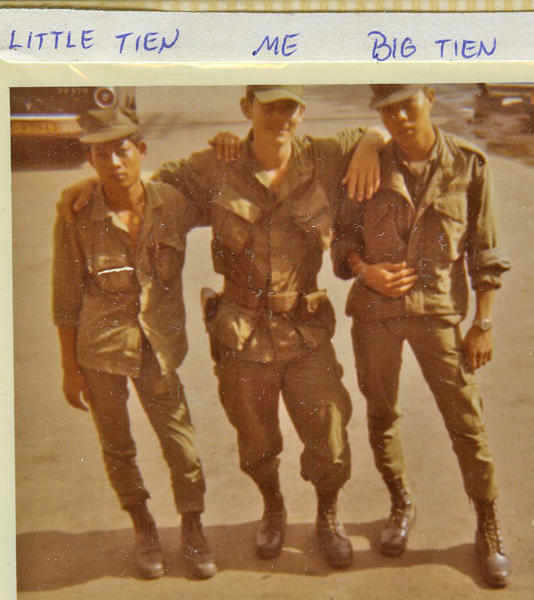
Above: A photo straight
out of my scrapbook with my hand written identification
at the top. On the left is Little Tien, me in the middle and on
the right is Big Tien.
Note I am wearing a .45 caliber pistol on my right hip attached
to a pistol belt
with spare magazines. One of the very few times when I had
polished boots
in Vietnam. Saigon December 24, 1970.
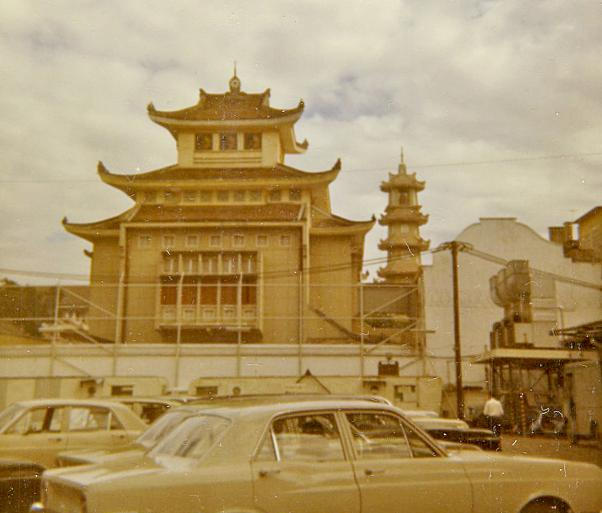
Above: The National
Chiêu Hôi Center in Saigon December 24, 1970. This is the only
photo I took of it
and is not a very good view. I wish I had taken a couple more
photos of it as I have never seen
any other photos of it anywhere.
Now that our duty was done Jim
and I were free until we had to report back to Tuy Hòa the next
day.
We had in effect an overnight pass to the big city. We got a cab
and went to a modest hotel where we
checked in for an overnight stay. The front of the hotel was a
sidewalk cafe and the entire area of it was
screened in by chain link fencing sides and roof to prevent
attacks by grenades or RPG
(Rocket Propelled Grenade.)
Upon checking in with the front
desk Jim and I were quite upset when we were told that if we had
any
weapons we were required to surrender them to the hotel for the
duration of our stay. We almost
refused to do such until we were shown a printed order from the
Provost Marshall's office which
instructed visiting soldiers to turn over their weapons to hotel
management. We were assured our
pistols would be kept in the hotel safe and would be returned to
us upon checkout. We got receipts
for the weapons but still I was not happy about being anywhere in
Vietnam unarmed.
After checking our room Jim and
I went to see the sights of the city. We got into a typical blue
and yellow
little Renault taxi and told the cabbie to drive us around to
view the major attractions. We rode by the
U.S. embassy, the Vietnamese Presidential Palace, the old French
section of the city known as Cholon,
and made a stop at the Saigon Zoo. The taxi brought us through
the city as we got a good look at life
in Saigon. I had brought two cameras and took a bunch of photos.
We exited the taxi at the end of
the famous Tu Do street where it began at the Saigon River. We
walked down
the street and stopped in at a bar or two, and then had a beer in
one of the old French style cafe's. We walked
by Notre Dame Cathedral and the old Opera House which now served
as the National Legislature.
We found either a Red Cross
office or U.S.O. establishment (I don't remember which) where I
was able to place
a phone call to the United States, to Lafayette, Louisiana and
the home of my parents. In those days before cell
phones and satellite communications overseas phone calls were
difficult and complicated, and you needed
special equipment to make such calls. There were only a few
places in Vietnam where such phone calls
could be made and this place was one of them.
I thought my parents would be
happy to hear from their only son who was 10,000 miles away doing
the
dangerous job of an Infantryman in a combat zone, and called to
wish them a Merry Christmas.
Instead I got my butt chewed out
by my mother for waking them up at 3 in the morning, for what was
not
an emergency.
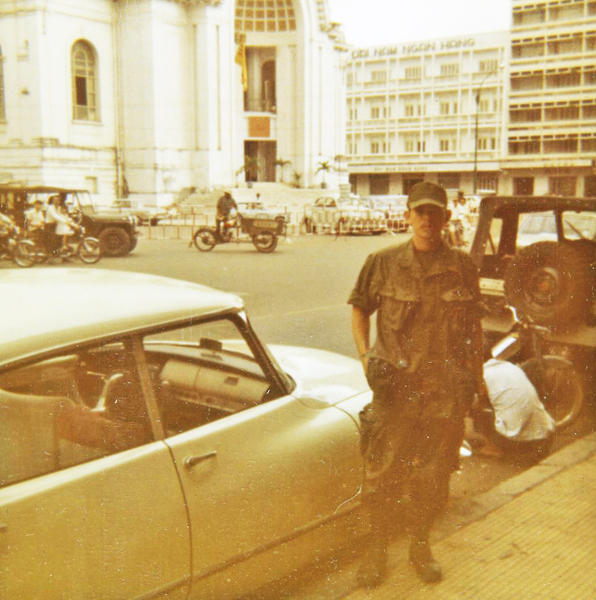
Above: Me standing next
to a French Citroën car. In the background on the left is the
old
Saigon Opera House which at the time was the National Legislature
building for South Vietnam.
On the right is the Caravelle Hotel. Saigon December 24, 1970.
|
Above: Card from The Lotus
Bar at 142 Tu Do Street in Saigon. |
Jim and I ended up at the Lotus
Bar for most of the night where we spent all our money buying
drinks
for us and the bargirls.
The next day, Christmas Day we
checked out of the hotel, retrieved our pistols, and caught a
taxi
to bring us to Tan Son Nhut airport. As we drove through the city
the traffic got heavy. Saigon
was laid out like a European city, where in several places a
number of streets melted together in
a big open traffic circle, or otherwise funneled down into one
avenue with hundreds of cars, trucks,
motorcycles and bicycles merging into one big mass of flowing
congestion. Our little taxi was swept
into this mass of humanity and machines, and slowed down to a
crawl.
I was not wearing my sidearm but
instead had it inside of the overnight bag I was holding on my
lap
in the back of the taxi. We were surrounded by a sea of people
all in a hurry to get somewhere and
as I looked out into unhappy faces stuck in traffic, with people
on bikes right up against our car I got
quite nervous. Up to this time my Vietnam experience had been of
being in the boonies or base camps
and not around civilians. The thought crossed my mind that any of
these seemingly innocent figures
around me could be Viet Cong just waiting for an opportunity to
injure or kill an American, and melt
away into the crowd. I reached inside my bag and gripped my .45
automatic tightly and held it that
way until we got to the airport. Of course there was no danger. I
was just being foolish.
Once we got back to Tuy Hòa the
guys in the Platoon were eager to hear about Saigon, and once
I got the photos I took developed they enjoyed looking at them
and listening to my descriptions
of the big city. The orders for Jim and I promoting us to the
rank of Sergeant were waiting for us.
The date of the orders was Christmas Day December 25, 1970.
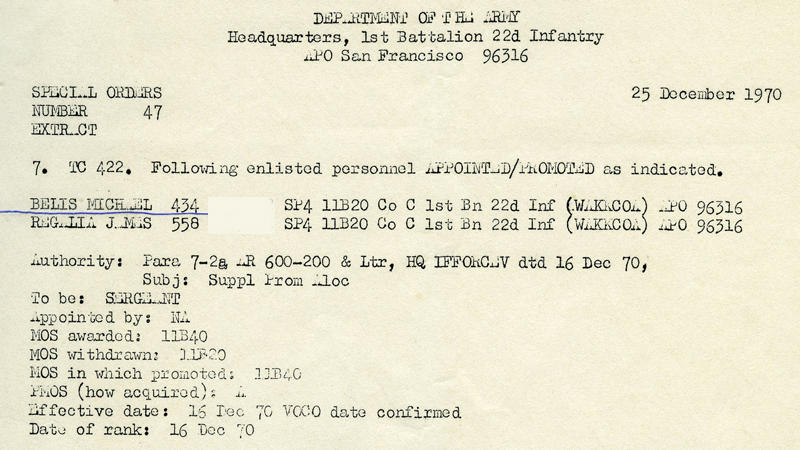
Above: The orders
promoting myself and Jim Regalia to Sergeant. The orders are
dated Christmas Day December 25, 1970
with effective date of rank back to December 16, 1970. My MOS
(Military Occupational Specialty) at the rank of SP4
(Specialist 4th Class) is given as 11B20. This is incorrect. My
MOS was actually 11B2U the "U" designation setting me
apart
from a normal Infantryman. It meant that I was also trained and
qualified as a tracked vehicle driver. I lost that MOS
designation
when promoted to Sergeant and given my new MOS of 11B40 (Infantry
Non-Commissioned Officer.)
In April 1975 I sat watching the
television as North Vietnamese tanks and soldiers moved through
the streets of Saigon. Watching the communist tanks crash through
the gate at the Presidential Palace
and communist soldiers tearing down the South Vietnamese Marine
Corps monument on Le Loi street
saddened me deeply. I had been at those places and taken photos
there.
More than anything else during
the fall of South Vietnam those images on the tv screen of the
victorious communist forces
taking over the city of Saigon brought out emotions in me about
my Vietnam experience I did not know I had.
I was mesmerized watching those images and couldn’t tear
myself away from the TV
even though it felt like someone had kicked me hard in the gut.
All photos, leaflets, insignia, bar card and orders above are from Michael Belis
Home | Photos | Battles & History | Current |
Rosters & Reports | Medal of Honor | Killed
in Action |
Personnel Locator | Commanders | Station
List | Campaigns |
Honors | Insignia & Memorabilia | 4-42
Artillery | Taps |
What's New | Editorial | Links |